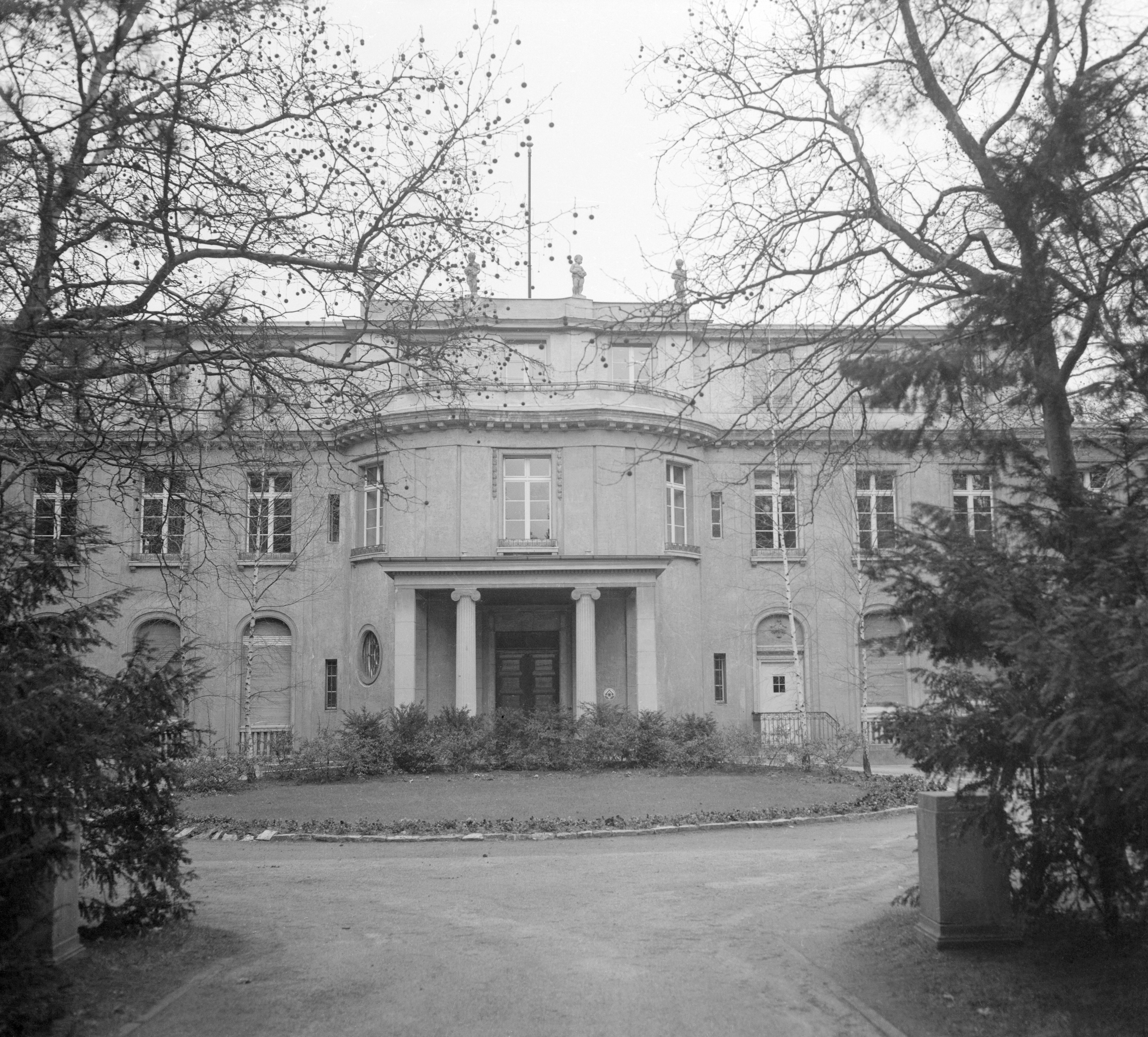You know the meeting—management convened it to present some new undertaking and solicit every body’s input. That is what neophytes believe, anyway; the more experienced know the score, and enter the conference room resigned, wary, even disposed to revolt. But the boss has clout enough to cram his agenda down everyone’s throats.
Such cramming occurs in all walks of life: governmental, commercial, educational, ecclesiastical. The conference held on January 20, 1942, in Wannsee, a lake side district southwest of Berlin, was like any other of its kind, except that the Schutzstafel—the SS—organized the conclave, whose agenda was the destruction of Europe’s 11 million Jews.
Directed by Frank Pierson, Conspiracy re-creates the Wannsee Conference in nearly real time, showing the mansion in which the gathering took place in a fly over shot and reproducing the building’s interior for the set. Writer Loring Mandel based his script on the “Wannsee Protocol”—the meeting’s top-secret minutes. The original document is deliberately vague; its language gives no hint that the subject is mass murder. Nor does the protocol paint the conference as anything less than wholly harmonious. But anyone who has watched bureaucrats battle over turf knows differently, and a close reading of the minutes suggests fault lines and objections. The filmmakers have fleshed out these intimations to deliver a riveting drama that takes place almost entirely around a large conference table.
Conspiracy, which premiered in 2001, opens with SS Lieutenant Colonel Adolf Eichmann (Stanley Tucci) fussing over touches for the conference that include excellent wines, fine cigars, and a lavish buffet lunch for 15. As they enter, the guests, representatives of some of Nazi Germany’s most powerful men, introduce themselves to one another and the viewer. Two look glum: Friedrich Wilhelm Kritzinger (David Trelfall), deputy head of the Reich Chancellery, whose boss, Hans Lammers, is among Hitler’s legal advisers; and Wilhelm Stuckart (Colin Firth), chief architect of the Nuremberg Laws that stripped German Jews of their civil rights, defining “Jew” using formulas of Stuckart’s devising. Kritzinger and Stuckart believe their offices resolved the “Jewish question.” Fretting that the SS is about to hijack that “question” and impose its own solution, the two quietly grouse to one another.
Last to appear is the man who called the meeting, SS Obergruppenführer Rein hard Heydrich (Kenneth Branagh), chief of the Reich Main Security Office. Heydrich presides with the jaunty air of a man assured that he is going places. He quotes a directive from Reichsmarschall Hermann Göring assigning Heydrich to find “a complete solution of the Jewish question in the German sphere of influence in Europe,” and also stipulating that relevant agencies “cooperate” with this endeavor. Kritzinger instantly objects; the Chancellery, he declares, has received no directive on this subject. He fruitlessly tries to gain a hearing but Heydrich smoothly and stubbornly plows on, leaving a sidelined Kritzinger to fume.
Heydrich explains that Nazi policy has been forcing Jews to leave Germany voluntarily or to “emigrate” involuntarily to German-instituted ghettoes in Polish cities. That has changed. Jews under Nazi control now number several million, with five million to be added as the con quest of the Soviet Union proceeds. Alas, that invasion has stalled. “We are standing still in Russia; the Americans have joined the war. Both events are a further drain on our military, our economy, our manpower, our food supply,” Heydrich says. “We cannot store these Jews. Emigration is over.” The new policy is “evacuation,” a term made clear as he fields queries.
“I have the real feeling I ‘evacuated 30,000 Jews already, by shooting them at Riga,” an SS major observes. “Is what I did ‘evacuation’?”
Yes, Heydrich says. Kritzinger rages. “That is contrary to what the Chancellery has been told. I have directly been assured!” the Chancellery’s man says. “Purge the Jews, yes…. But to systematically annihilate all the Jews of Europe? That possibility has personally been denied to me by the Führer.”
“And it will continue to be,” Heydrich replies, locking eyes with Kritzinger to let his message sink in.
Stuckart protests—out of territoriality, when he sees that Heydrich is going to junk his genealogical formulas for identifying Jews. Without his equations, Stuck art warns, legal chaos will ensue. Kritzinger and Stuckart—supported by other of the bureaucrats on hand—suggest that instead of killing these Untermenschen the Nazis sterilize them.
“We won’t sterilize them and wait until they die. That’s farcical,” the SS man says. “Dead men don’t hump. Dead women don’t get pregnant. Death is the most reliable form of sterilization. Put it that way.”
Heydrich has Eichmann outline programs for gassing Jews. So far, the participants who control Poland have delighted to watch Heydrich run rampant over Kritzinger and Stuckart. Now it dawns on them that most of what Eichmann is describing has been going on in Poland under their noses, without their knowledge. Soon everyone understands this “consultation” to have been more of a sham than anyone could have guessed.
The meeting adjourns. The officials walk to their cars, shaken—not by the industrialized horror they now realize to be taking place, but by the bureaucratic tour de force they have witnessed.
Originally published in the June 2015 issue of World War II. To subscribe, click here.





